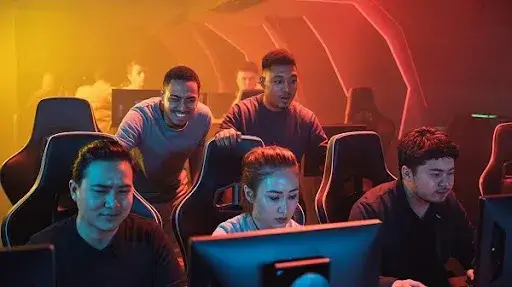Players don’t just want a game anymore. They want a place to return to, something that keeps giving them reasons to log back in. That’s why live service games are everywhere. Studios aren’t treating launches as an ending. They’re treating them as the starting line.
Fortnite, Destiny 2, Genshin Impact, Call of Duty: Warzone, GTA Online, these aren’t just hits. They’re proof that games as a service have turned into one of the most profitable and community-driven formats in the industry. They don’t fade out after launch. They build momentum.
Live service games hook players with progression systems, seasonal drops, fresh content, events, limited-time cosmetics, social features, clans, and battle passes. And because players stick around longer, studios get more room to experiment with game monetization models, content updates in gaming, and long-term player engagement.
The pull isn’t accidental. It’s built into the design from day one.
Why Live Service Games Became the Standard Everyone’s Chasing
Traditional single-purchase games live and die by launch day. But live service games stretch their lifespan and revenue for years using a live service business model. Instead of relying on one big sales spike, studios lean into microtransactions, cosmetics, paid expansions, game passes, and season-based rewards.
The biggest change? Players expect the content to keep coming. Live game maintenance has turned into a core part of game development post-launch. The update schedule isn’t optional anymore; it’s part of the identity.
Studios also get a direct line to their audience. Player feedback in games has never mattered more. Developers can patch, balance, add features, or remove anything that doesn’t land well. Community-driven games thrive when the audience feels heard and rewarded.
And there’s another reason this model works: attention spans are short. Constant drops, quests, and surprises help keep a game relevant in a sea of new releases.
Fact: Live service games make up 70–75% of the overall revenue generated by the global gaming industry.
The GaaS Model Isn’t Just a Format, It’s a Strategy
Games as a service (GaaS model) gives studios the space to expand, refine, and monetize without restarting development from scratch. Instead of building a sequel, they update the foundation. That means lower risk, higher ROI, and a long-term connection with the playerbase.
Here’s what makes the live service business model so attractive to studios and publishers:
- Revenue doesn’t peak at launch
- New content becomes an ongoing product
- Player retention strategies are measurable
- Updates can fix underperforming features instead of abandoning them
- Fans turn into communities, not one-time buyers
Continuous game development keeps the product fresh and gives developers the freedom to respond to trends. One update can completely revive a title. One new character can reignite hype. One seasonal event can bring back players who left months ago.
Why Players Keep Coming Back to Live Service Games
Most people won’t replay a finished game unless they’re extremely attached to it. Live service games solve that by moving the finish line again and again.
The biggest draws for players include:
Social and Online Multiplayer Experiences
Live service games are built on shared experiences. Multiplayer live service games let people squad up, compete, trade, show off skins, compare stats, or group up for raids. Community is baked into the format.
New Content Without Buying a New Game
Content updates in gaming give players something new to do without buying a separate title. Fresh missions, maps, cosmetics, and characters roll in on schedule.
Frequent Challenges and Events
Live event gaming keeps gameplay from going stale. Holiday events, battle pass challenges, seasonal themes, collaborations with shows or brands, there’s always something temporary players don’t want to miss.
Long-Term Progression
Leveling systems, unlock tracks, skins, ranked modes, and achievements keep players invested. Nobody likes losing progress, and that psychological momentum drives retention.
Community and Status
In live service games, cosmetic items can be status symbols. Completing old events, finishing raids, or buying rare skins gives players something to show off. That alone keeps many coming back.
The Real Benefits of Live Service Games for Studios
The benefits of live service games stretch far past stable revenue. When executed well, these titles create living ecosystems where updates, events, and systems reinforce each other.
Here’s what studios gain:
Extended Lifespan
A single release can last five to ten years with smart planning. That reduces the need to start new projects constantly.
Scalable Monetization
Game monetization models expand with player interest. Season passes, DLC, skins, and limited drops give studios more options than a single full-price sale.
Player Data and Feedback
Studios get live stats on engagement, spending habits, and feature popularity. That helps guide future updates and prevents wasted effort.
Constant Marketing Built In
Every new season or event acts like a marketing campaign. Players promote it through streaming, social media, and word of mouth.
Stronger IP Development
One game can spawn spin-offs, merchandise, animated series, or esports scenes if the community sticks around.
The Role of Game Animation Services and Content Drops
Visual updates matter in live service games. Game animation services play a major role in seasonal refreshes, character additions, and cosmetic skins. When players pay for something, it has to feel new, polished, and worth the hype.
Animations bring new abilities, weapons, emotes, cutscenes, and live events to life. The more distinctive the style, the more memorable the update.
Game updates and content drops aren’t just patch notes. They’re an entire event cycle. The expectation is:
- New characters and skins
- Fresh missions or modes
- Story expansions
- Rewards tied to challenges
- QoL improvements
- Balancing tweaks
A good launch update fuels excitement. A weak one kills momentum.
How Player Retention Strategies Drive Everything
Content alone isn’t enough. Player retention strategies are what turn updates into loyalty.
Some of the most common models used in live service game development:
Battle Passes and Season Tracks
Players unlock cosmetics and rewards by completing challenges. The pass gives them goals and keeps them logging in.
Clans, Guilds, and Teams
Social accountability is powerful. Nobody wants to fall behind their squad.
Timed Events
Limited windows boost urgency. Players jump back in so they don’t miss out.
Reward Loops
XP systems, daily missions, login bonuses, loot rotations, these keep momentum going.
Live Event Gaming
In-game concerts, collaborations, crossovers, or boss events generate buzz and media coverage.
Retention strategies work best when the rewards feel meaningful and the grind doesn’t feel like punishment.
Live Service Gaming Trends
Studios can’t copy-paste old models. New expectations are shaping how future games as a service are built.
Some of the biggest live service gaming trends right now:
Hybrid Monetization
Instead of choosing between paid and free-to-play, studios mix both. Free entry, paid cosmetics, and occasional expansions give flexibility to all types of players.
Community-Driven Content
Player feedback in games helps shape new features. Developers ask, adjust, and update based on actual usage.
Crossplay and Cross-Progression
Locking platforms are outdated. Players expect to access their accounts and skins anywhere.
Seasonal Storytelling
Seasons now come with narrative arcs, not just cosmetic rewards. Destiny 2 and Fortnite built that playbook.
Collabs and Pop Culture Tie-ins
Bringing in celebrities, brands, anime, sports, and music turns updates into major events.
Quality Over Quantity
Live game features that feel rushed spark backlash. Studios are now spacing updates better to avoid burnout.
Smarter Game Content Lifecycle Planning
Developers plan years ahead now. Seasonal roadmaps help players know what to expect without spoiling surprises.
How Live Service Game Development Actually Works Post-Launch
Launching the game is step one. The real work starts afterwards.
Here’s what studios juggle during continuous game development:
- Content pipeline: Missions, skins, characters, maps, weapons, mechanics
- Balancing updates: Fixing power creep and broken meta issues
- Bug fixes and polish: Live game maintenance never stops
- Server upkeep: Multiplayer live service games need stability
- Player communication: Roadmaps, patch notes, community replies
- Monetization planning: Drops, bundles, passes, limited-time offers
- Internal coordination: Art, writing, animation, coding, QA, marketing
Most teams treat the launch as a beta phase that leads into the real product rhythm.
Why Traditional One-Time Releases Fall Behind
Single-purchase titles can still succeed, but they don’t have the same staying power unless they bolt on live service elements later. The biggest limitation? Static lifespan.
Once a player finishes the campaign, there’s nowhere else to go. No updates. No evolving ecosystem. No social traction. No reason to check back.
Meanwhile, live service games grow richer over time. They become less disposable. Player investment doesn’t end when the credits roll, because there are no credits.
Examples of Live Service Models
To understand why they’re so in-demand, just look at the range of successful approaches:
Fortnite – Battle passes, licensed collabs, map overhauls, and turning concerts into gameplay.
Destiny 2 – Seasonal story arcs, raids, expansions, and consistent live game maintenance.
Warframe – Free-to-play longevity with huge updates, movement innovation, and community loyalty.
Genshin Impact – Gacha model with world expansion and constantly refreshed characters.
Apex Legends – Rotating seasons, competitive modes, and character-based storytelling.
Each one uses different monetization models, content rhythms, animation demands, and retention strategies, but the outcome is the same: sustained growth.
The Business Side: Why This Model Wins
Studios don’t favor live service games just because players enjoy them. They favor them because revenue continues long after launch, which reduces financial pressure and risk.
A one-time-sale game might sell 2 million copies and disappear from the charts in two months.
A live service title might have the same initial numbers but generate income every quarter for five years. That’s why investors back them. That’s why publishers push them. That’s why indie teams adopt scaled-down versions.
And when animation, art, story, and content need to scale, outsourcing becomes a cost-effective lever instead of overstaffing in-house teams.
Challenges Developers Face (and Why Support Matters)
It’s not all upside. Live service games crash and burn when they can’t keep up.
The biggest risks include:
- Content droughts
- Unbalanced monetization
- Server instability
- Weak animation updates
- No community roadmap
- Poor communication
- Burnout on dev teams
To keep up with demand, many studios bring in specialists, especially for animation, character updates, trailers, cutscenes, and seasonal assets. That kind of support prevents teams from collapsing under constant production cycles.
Frequently Asked Questions
What is a live service game?
It’s a game designed to keep evolving after launch through frequent updates, events, content drops, and ongoing player interaction.
Are live service games free-to-play only?
No. Many are free-to-play, but paid titles like Destiny 2 and Final Fantasy XIV follow the same ongoing update model.
How do live service games make money?
Through battle passes, expansions, cosmetics, DLCs, in-game events, and optional purchases, not just the initial purchase.
Why do players stay longer in these games?
Community ties, ongoing content, customization, rewards, competition, and fear of missing future drops all play a part.
Do live service games require constant internet?
Most do, especially those focused on multiplayer experiences and real-time updates.
What makes a live service game fail?
Slow content rollout, weak communication, bad monetization, technical issues, or ignoring player feedback.
Can single-player games use this model?
Yes. Titles can blend both by adding expansions, seasonal modes, or new areas post-launch.
Final Words
Live service games aren’t trending; they’re becoming the blueprint. Players want evolving worlds. Studios want recurring revenue. Communities want places to gather, compete, and explore.
But pulling it off takes more than code and hype. It takes consistent animation, polished updates, adaptable design, and a content engine that never slows down. That’s where outside partners make the difference.
If you’re building or scaling a live service title and need a team that can handle animation, cinematics, trailers, character rigs, or seasonal content, Prolific Studio plugs into your pipeline without slowing production.
You focus on the vision. We handle the execution.
Just say the word when you’re ready to power up your live service game.
Related Articles:










